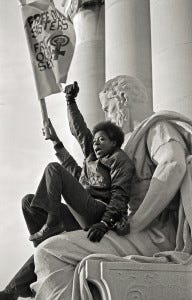From Cheryl Sandberg’s momentous yet controversial release of “Lean In” to the UN’s “HeForShe” campaign and Beyoncé’s VMA performance, feminism has re-emerged as a hot topic around the world, so much so that men and women alike are participating in a global conversation.
The film “She’s Beautiful When She’s Angry” both drives and informs that conversation while providing inspiration for a splintered movement in a dynamic historical documentary.
“She’s Beautiful,” directed and produced by Mary Dore, relies on interviews with leaders of the historic feminist movement along with video footage, photographs and performance to paint the story of women’s liberation between 1966 and 1971. No narrator slows the film’s pace, which brings the audience into what feels like a current and dynamic conversation between these powerful female voices.
The story starts with the formation of the National Organization for Women (NOW) and the splintering off of the more radical, younger women’s liberation organizations.
Consciousness-raising groups became widespread during this period. The enthusiasm of the film’s interviewees and the sequenced precision of its monologues bring audience members onto the living room floor of one of these meetings. It is as if all of the women are sitting together, weaving a radiant tapestry of truth and perspective.
But they don’t all agree. One of the criticisms of second-wave feminism is its middle-class whiteness and inflexibility in incorporating a diversity of needs. “White women had a hard time acknowledging different priorities. Women who spent their lives in other women’s kitchens have a different kind of disadvantage,” says Linda Burnham, founder of Black Sisters United.
Gay women also had an additional battle to wage. Betty Friedan, NOW founder, had called them “the Lavender Menace,” and they were seen by some as harmful to the progress already made. Joyfully, Rita Mae Brown, feminist writer, remembers how she galvanized lesbians into action at the Second Congress to Unite Women in 1970, ultimately forcing the larger organizations to listen to those voices.

It is these disagreements that both challenged the movement’s progress and allowed for its accomplishments.
The “personal as political” concept tied these fractious poles together. Women united around employment discrimination, reproductive health and the right to childcare. Significant accomplishments of the era included incorporating women into university curricula, the legalization of abortion, legislation on domestic violence and demanding a voice in the senate on hearings on the birth control pill.
Ultimately this movement succeeded in forcing a discourse on women in society. “She’s Beautiful” admits that while there is still much work to be done, entire fields of work were closed off to women that are now open — that reverting on this reality is undoable.
“She’s Beautiful” is not only useful for feminists seeking inspiration, but also provides a much-needed toolkit for the modern activist. As Susan Brownmiller of the Congress of Racial Equality reminds viewers, the U.S. doesn’t like to admit, “change happens because radicals force it.”
“She’s Beautiful” captures the excitement women felt at the time, the momentum and increasing rapidity of progress that took place through intrepid, calculated action. It gives our generation its blessing with an instruction manual — dated, but still relevant.
The film is currently playing at Landmark Cinemas in Berkeley. For more information, visit shesbeautifulwhenshesangry.com.

























